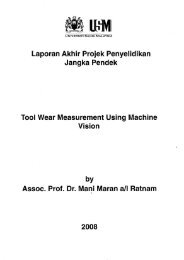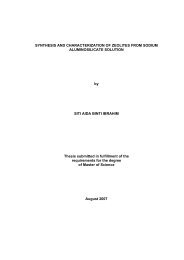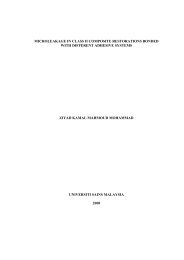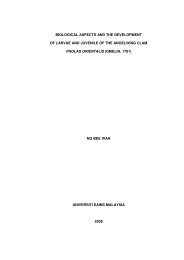a study on the performance of limestone roughing filter - ePrints@USM
a study on the performance of limestone roughing filter - ePrints@USM
a study on the performance of limestone roughing filter - ePrints@USM
You also want an ePaper? Increase the reach of your titles
YUMPU automatically turns print PDFs into web optimized ePapers that Google loves.
2.10 Removal Capabilities <strong>of</strong> Roughing Filter<br />
In <strong>the</strong> following secti<strong>on</strong>, removal capabilities <strong>of</strong> <strong>roughing</strong> filtrati<strong>on</strong> studies are<br />
presented. The major parameters discussed in this secti<strong>on</strong> are removal <strong>of</strong> turbidity,<br />
suspended solids, total coliform and biochemical oxygen demand. The following<br />
secti<strong>on</strong> is a <strong>performance</strong> comparis<strong>on</strong> <strong>of</strong> previous researches.<br />
2.10.1 Turbidity Removal in Roughing Filter<br />
Roughing <strong>filter</strong>s could achieve peak turbidity removal ranging from 60% to 90%.<br />
Generally, <strong>the</strong> more turbid <strong>the</strong> water, <strong>the</strong> greater in reducti<strong>on</strong> could be achieved (WHO,<br />
2004). Roughing <strong>filter</strong>s could remove clay particles more effectively when <strong>the</strong> <strong>filter</strong> was<br />
ripen with algae cells (WHO, 2004). Rooklidge et al. (2004) found that turbidity removal<br />
using limest<strong>on</strong>e <strong>filter</strong> media with average porosity <strong>of</strong> 0.46 was 79%.<br />
Mahvi et al. (2004) revealed that <strong>the</strong> <strong>performance</strong> <strong>of</strong> horiz<strong>on</strong>tal flow <strong>roughing</strong><br />
<strong>filter</strong> could improve by applying coagulant prior to filtrati<strong>on</strong>. They have shown that a<br />
horiz<strong>on</strong>tal flow <strong>roughing</strong> <strong>filter</strong> using three different size <strong>of</strong> 12-18 mm, 8-12 mm and 4-8<br />
mm <strong>filter</strong> media with flow rate <strong>of</strong> 2 m/h, has produced good effluent quality, less than 2<br />
NTU from raw water quality <strong>of</strong> 200-400 NTU. Culligan (2005) described that chemical<br />
pretreatment could increase <strong>filter</strong>ed water clarity, measured in NTU in <strong>the</strong> range <strong>of</strong><br />
93%-95% removal. WHO (2004) also supported that additi<strong>on</strong> <strong>of</strong> alum before treatment<br />
with a horiz<strong>on</strong>tal <strong>roughing</strong> <strong>filter</strong> could improve <strong>the</strong> <strong>filter</strong>’s <strong>performance</strong> for turbidity,<br />
color, organic carb<strong>on</strong>, head loss and <strong>filter</strong> run time. Mwiinga et al. (2004a) also<br />
supported that adding lower coagulati<strong>on</strong> dose by gravity could treat higher turbidity raw<br />
water and enhanced turbidity removal in upflow gravel <strong>roughing</strong> <strong>filter</strong>s. However, n<strong>on</strong>e<br />
<strong>of</strong> <strong>the</strong>m describes <strong>the</strong> effect <strong>of</strong> <strong>the</strong> variati<strong>on</strong> in dosage amount <strong>of</strong> coagulant <strong>on</strong> <strong>the</strong> <strong>filter</strong><br />
<strong>performance</strong>.<br />
24

















